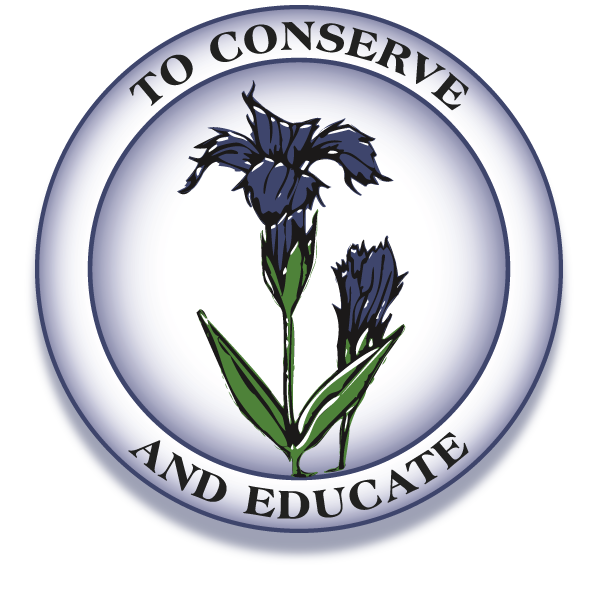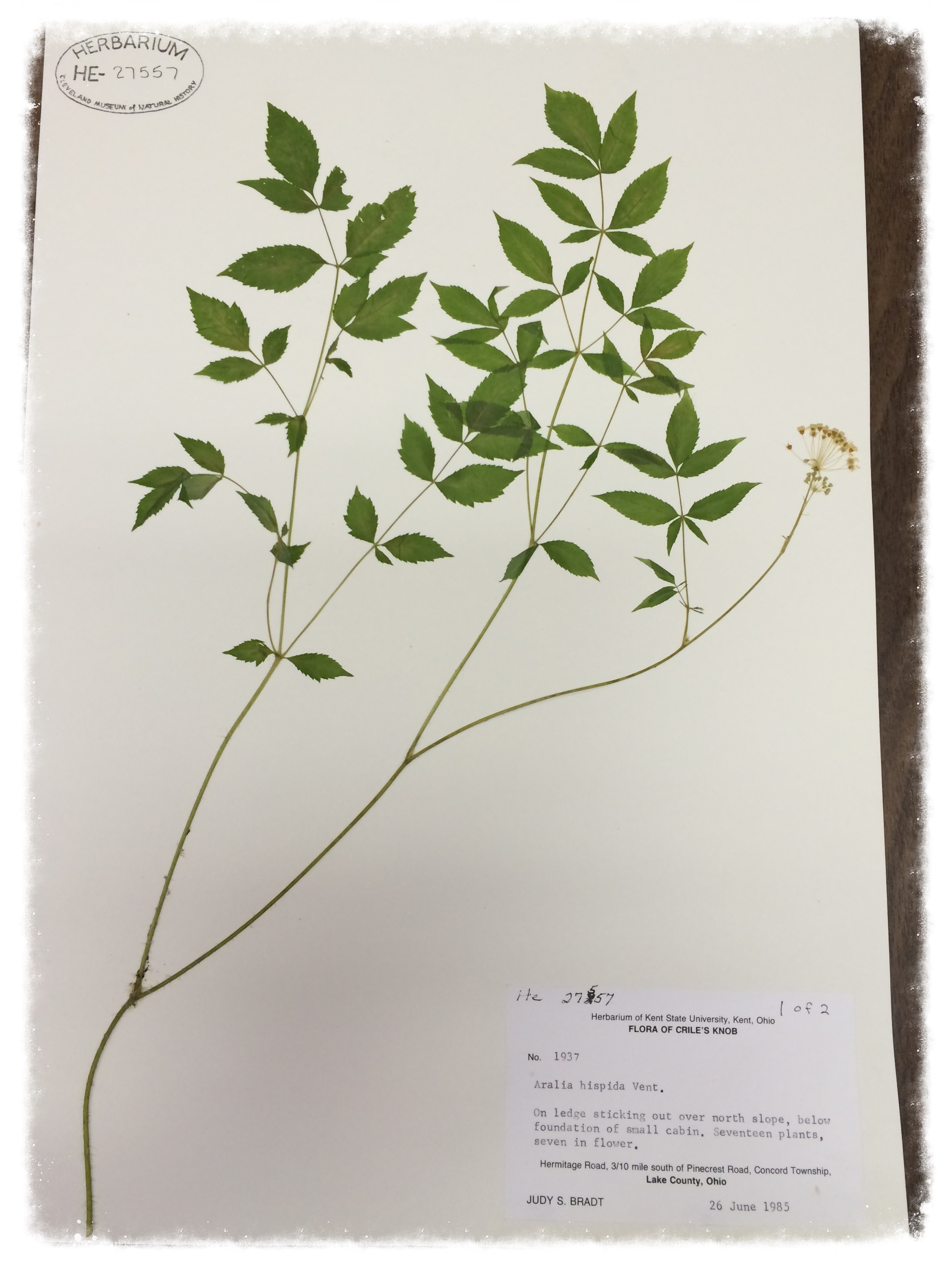
Field Notes
Native Plant Society of Northeastern Ohio
From Field to Herbarium
30 January 2016
On Saturday, January 30, 2016, Jim Bissell, Curator of Botany at the Cleveland Museum of Natural History hosted our society's From Field to Herbarium program. The beautiful winter weather inspired many across the region to visit the museum on this day. Upon arrival, several in our group were met with a "lot full" sign which required additional time seeking alternative parking at other nearby museum facilities or plugging street meters. The slight delay this caused only heightened the anticipation for this program. Once all participants were in attendance, our standing-room-only group of nineteen individuals gathered in the herbarium to learn about the intricacies of overseeing the stewardship of a plant collection. The afternoon program passed too quickly as our host captivated our attention with details of the herbarium history, research conducted by the botany department to document the flora of northeastern Ohio as well as eastern Pennsylvania, and his field travels. He even surprised me by showing some of the old rare plants I had collected in the 1980's and 90's as part of my masters research and Geauga Park District botany work!
Aralia hispida, bristly sarsaparilla, specimen collected by Judy Bradt during her graduate studies research in the field. Close-ups of A. hispida specimen and label.
Courtesy of The Cleveland Museum of Natural History, Trish Fox, Herbarium Coordinator
Cornus canadensis, bunchberry dogwood, specimen collected by Judy Bradt-Barnhart during her work with Geauga Park District. Close-ups of C. canadensis specimen and label.
Courtesy of The Cleveland Museum of Natural History, Trish Fox, Herbarium Coordinator
We wholeheartedly wish to thank Jim Bissell for sharing his time and enlightening us on the collective contributions of dedicated individuals whose appreciation for nature resulted in the irreplaceable resource collection of plant specimens that is now safely sheltered and cared for at The Cleveland Museum of Natural History.
The current storage facilities and cataloging methods of the herbarium plant specimens evolved over the years under the guidance and direction of Jim Bissell. When he started at the museum, plant collections were in boxes and crates and a few herbarium cabinets. Many of the historical specimens from the nineteenth and early twentieth century had non-specific locality data such as "Cuyahoga County", "Geauga County", "near Chardon", or "south of Oberlin". This lack of location specificity made post surveying field work efforts difficult. It was only after many years of searching that some of these plants were eventually rediscovered. In 1985, the museum's herbarium collection received a historically important 9,000-specimen plant collection donation. The Case Western Reserve University herbarium collection housed at The Holden Arboretum was transferred to the museum. Several plant specimens within this collection were collected in the late 1800's and were not previously reported flora of Ohio. Many of the records are the only evidence of rare natural occurring communities now no longer present due to being destroyed more than a century ago.
Of particular interest and importance are three plant specimens from the Case Western Reserve herbarium collection. Bog rosemary, two-seeded sedge, and sparse-flowered sedge were collected by Edo Claasen on 31 May 1896 on the outskirts of Canton at a bog-fringed glacial lake known as Meyers Lake.
Andromeda polifolia: Ohio Memory Collection
Citation: www.ohiomemory.org/cdm/singleitem/collection/p267401coll36/id/2811/rec/1
Carex disperma: Northern Great Plains Herbaria
Citation: www.ngpherbaria.org/portal/collections/individual/index.php?occid=7557366
Carex teniuflora: Northern Great Plains Herbaria
Citation: www.ngpherbaria.org/portal/collections/individual/index.php?occid=7577837
Andromeda polifolia, bog rosemary is listed as extirpated from Ohio. Museum herbarium staff and volunteers have been searching for both sedges. Carex tenuiflora, sparse-flowered sedge remains listed as extirpated. Carex disperma, two-seeded sedge has been surveyed in four locations in Ashtabula, Portage, and Summit Counties. The museum herbarium now has more than 75,000 specimens of which Jim Bissell estimates he has collected over 40,000 plants during his tenure. When other plant specimen collections are brought to the museum precautions are taken to prevent introduction of organisms that could damage the quality and integrity of the existing herbarium plant specimens. For example, the sources are frozen to kill any dermestid beetles that could eat the plants in the collection.
The botanical data gathered from field inventories coordinated by Jim Bissell throughout the region including land preserves owned by the museum's Natural Areas Division, which now total over 7,000 acres, provided important information on rare plant occurrences to the Natural Heritage Program.
In 2005, the museum cleared a sand barren opening of shrubs and trees at the North Kingsville Sand Barrens, one of fifty-four preserves owned by the museum. After opening the canopy, Jim Bissell discovered several plants of Geranium bicknellii, Bicknell's geranium had germinated from the seed bank.
Geranium bicknellii: Jennifer Anderson, hosted by the USDA-NRCS PLANTS Database
The seeds of many plants restricted to open sand barrens or rock barrens, can remain dormant until habitat conditions favoring their growth return. Bicknell's geranium had never been reported for Ashtabula County prior to its appearance in the cleared opening. Since then, it has been relocated within the Oak Openings west of Toledo. This is just one example of the importance of gathering and maintaining this data. It is especially important now that the Natural Heritage Program which maintains records of rare Ohio flora is in jeopardy.
Awareness, botanical information, keen observation, vigilant efforts, and a bit of good fortune are required to spot the rare plants of this region. If a plant isn't observed in Ohio in twenty years it becomes listed as extirpated. The challenge is to look for some of the plants that haven't been observed in the wild for some time. More volunteers are needed to search for the plants in the field as limited funding prevents hiring. State botanists will meet this February to update the rare plant list.
During the winter months, Jim Bissell is focused on raising funds to hire staff and to purchase property that protects many rare plants and habitats. He and his staff will conduct a survey of a property upon request of its owner who wishes to know what is growing there.
This is how he found the extirpated-listed Populus heterophylla, swamp cottonwood in Painesville on a property that is now owned and protected by the museum.
Judy Bradt-Barnhart
Populus heterophylla herbarium sheet: Ohio Memory Collection, collaborative project of The Ohio History Connection and the State Library of Ohio
Description: William Werner, a resident of Painesville and botanist at the Ohio State University, collected this Populus heterophylla, or swamp cottonwood specimen. It is the only known swamp cottonwood record for Lake County in the nineteenth century. It is pressed onto an 11" x 17" (27.9 cm x 43.18 cm) sheet of paper.
Before 1985 the species was presumed to be extirpated, or eliminated, in Ohio. The Lake County population was re-discovered by the Cleveland Museum of Natural History in 1990 and has since been protected by the museum.
Date of Original: 1880
Source: Natural history specimen(s); HE-7026 Submitting Institution Cleveland Museum of Natural History
Citation: www.ohiomemory.org/cdm/singleitem/collection/p267401coll36/id/21718/rec/1
Native Plant Society of Northeastern Ohio, From Field to Herbarium program at CMNH 30.i.2016
edits: Jim Bissell, Jane McCullam; research, layout, edits, photograph: Lisa K. Schlag







